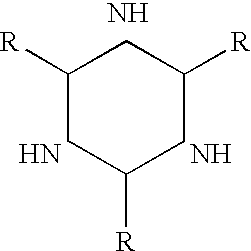Perfluoroelastomers having a low glass transition temperature and method of making them
- Summary
- Abstract
- Description
- Claims
- Application Information
AI Technical Summary
Benefits of technology
Problems solved by technology
Method used
Image
Examples
example 1
A 4 1-vessel was charged with 2.8 1 0.sub.2 -free water containing 10 g APFO and 8 g ammonia-oxalate. Additionally 150 g MV 31 pre-emulsified in water, 3 g BTFE and 180 g TFE were added and the polymerization was initiated at 60.degree. C. by adding 30 ml of 0.2% KMnO.sub.4 -solution. The polymerization was continued at 60.degree. C. and 9 bar pressure for 5 h, during this time 0.6 g KMnO.sub.4, 8 g BTFE, 550 g TFE and 600 g MV 31 pre-emulsified in water were continuously added. The clear latex was coagulated by adding MgCl.sub.2 -solution, the washed gum was dried at 130.degree. C. The resulting polymer has T.sub.G of -23.degree. C., a Mooney value of 70 and consists of 76.9 mol-% TFE, 22.5 mol-% MV 31 and 0.6 mol-% BTFE.
examples 2 to 7
The fluoroelastomers of examples 2 to 7 were prepared according to the polymerization method described in example 1 but with the exception that the monomers and amounts as indicated in table 1 were used.
Cure Properties
example 3
100 Parts of Example 3 were compounded with 15 parts carbon black MT N990 and 1 part Urotropin (hexamethylene tetramine). A sheet of the compounded mixture was pressed for 30 minutes at 177.degree. C. and then subsequently post-cured under nitrogen using the following conditions: 25-200.degree. C. in 6 hrs., 200.degree. C. for 16 hrs, 200.degree. C.-250.degree. C. in 2 hrs, 250.degree. C. for 8 hrs, 250.degree. C.-300.degree. C. in 2 hrs and 300.degree. C. for 16 hrs. The cured samples were tested to the indicated test methods, giving the following results:
Cure Properties
PUM
| Property | Measurement | Unit |
|---|---|---|
| Angle | aaaaa | aaaaa |
| Glass transition temperature | aaaaa | aaaaa |
| Temperature | aaaaa | aaaaa |
Abstract
Description
Claims
Application Information
 Login to View More
Login to View More - R&D
- Intellectual Property
- Life Sciences
- Materials
- Tech Scout
- Unparalleled Data Quality
- Higher Quality Content
- 60% Fewer Hallucinations
Browse by: Latest US Patents, China's latest patents, Technical Efficacy Thesaurus, Application Domain, Technology Topic, Popular Technical Reports.
© 2025 PatSnap. All rights reserved.Legal|Privacy policy|Modern Slavery Act Transparency Statement|Sitemap|About US| Contact US: help@patsnap.com



